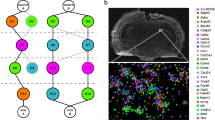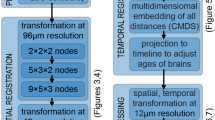Abstract
To better understand the development and function of the mammalian brain, researchers have begun to systematically collect a large number of gene expression patterns throughout the mouse brain using technology recently developed for this task. Associating specific gene activity with specific functional locations in the brain anatomy results in a greater understanding of the role of the gene’s products. To perform such an association for a large amount of data, reliable automated methods that characterize the distribution of gene expression in relation to a standard anatomical model are required. In this paper, we present an anatomical landmark detection method that has been incorporated into an atlas-based segmentation. The addition of this technique significantly increases the accuracy of automated atlas-deformation. The resulting large-scale annotation will help scientists interpret gene expression patterns more rapidly and accurately.
Chapter PDF
Similar content being viewed by others
References
Herzig, U., Cadenas, C., Sieckmann, F., Sierralta, W., Thaller, C., Visel, A., Eichele, G.: Development of high-throughput tools to unravel the complexity of gene expression patterns in the mammalian brain. In: Bock, G., Goode, J. (eds.) Complexity in Biological Information Processing, ovartis Foundation Symposium 239, pp. 129–149. John Wiley & Sons, Chicester (2001)
Carson, J., Thaller, C., Eichele, G.: A transcriptome atlas of the mouse brain at cellular resolution. Current Opinion in Neurobiology 12, 562–565 (2002)
Visel, A., Thaller, C., Eichele, G.: Genepaint.org: an atlas of gene expression patterns in the mouse embryo. Nucleic Acids Research 32, D552–556 (2004)
Carson, J.: Quantitative annotation and analysis of gene expression patterns with an atlas of the mouse brain. PhD thesis, Baylor College of Medicine (2004)
Ju, T., Warren, J., Eichele, G., Thaller, C., Chiu, W., Carson, J.: A geometric database for gene expression data. In: Kobbelt, L., Schröder, P., Hoppe, H. (eds.) Eurographics Symposium on Geometry Processing, Aachen, Germany, pp. 166–176 (2003)
Warren, J., Weimer, H.: Subdivision Methods for Geometric Design: A Constructive Approach. Morgan Kaufmann Publishers, San Francisco (2002)
Jain, A.K., Duin, R.P.W., Mao, J.: Statistical pattern recognition: A review. IEEE Transactions on Pattern Analysis and Machine Intelligence 22, 4–37 (2000)
Plutowski, M., White, H.: Selecting concise training sets from clean data. IEEE Transactions on Neural Networks 4, 305–318 (1993)
Duda, R.O., Hart, P.E., Stork, D.G.: Pattern Classification. John Wiley & Sons Inc. Chichester (2001)
Vapnik, V.N.: The Nature of Statistical Learning. Springer, Heidelberg (1998)
Freund, Y., Schapire, R.E.: An introduction to boosting. Journal of Japanese Society for Artificial Intelligence 14, 771–780 (1999)
Schölkopf, B., Smola, A.: Learning with Kernels. MIT Press, Cambridge (2002)
Hsu, C., Chang, C., Lin, C.: A practical guide to support vector classification. Technical report, National Taiwan University, Taipei 106, Taiwan (2003)
Author information
Authors and Affiliations
Editor information
Editors and Affiliations
Rights and permissions
Copyright information
© 2004 Springer-Verlag Berlin Heidelberg
About this paper
Cite this paper
Kakadiaris, I.A. et al. (2004). Landmark-Driven, Atlas-Based Segmentation of Mouse Brain Tissue Images Containing Gene Expression Data. In: Barillot, C., Haynor, D.R., Hellier, P. (eds) Medical Image Computing and Computer-Assisted Intervention – MICCAI 2004. MICCAI 2004. Lecture Notes in Computer Science, vol 3216. Springer, Berlin, Heidelberg. https://doi.org/10.1007/978-3-540-30135-6_24
Download citation
DOI: https://doi.org/10.1007/978-3-540-30135-6_24
Publisher Name: Springer, Berlin, Heidelberg
Print ISBN: 978-3-540-22976-6
Online ISBN: 978-3-540-30135-6
eBook Packages: Springer Book Archive




